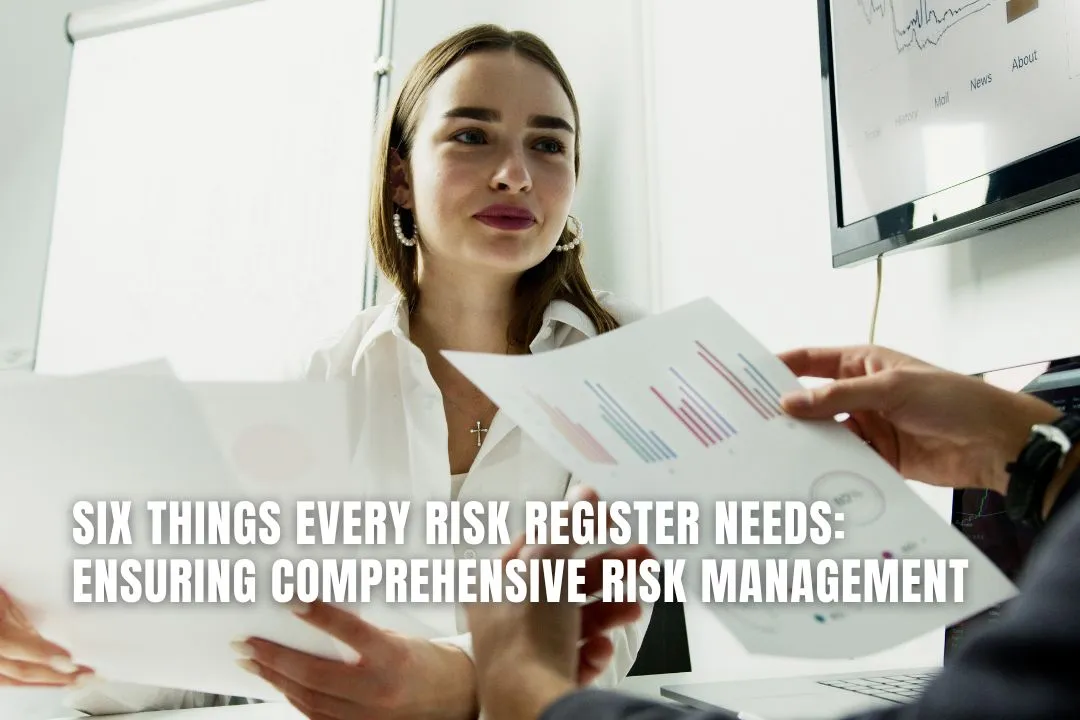Six Things Every Risk Register Needs: Ensuring Comprehensive Risk Management
December 11, 2024

Risk management is crucial for any organization aiming to thrive in today's uncertain world. A risk register serves as a vital tool, helping businesses identify, assess, and manage risks effectively. In this article, we will explore the essential elements of a risk register, ensuring that organizations can navigate potential challenges with confidence.
Key Takeaways on Risk Management
- Risk Identification: Identifying potential risks early is crucial for effective risk management. This includes understanding the types of risks, asking the right questions, and involving the team in the identification process.
- Risk Description: A clear and concise risk description provides an overview of the risk and its potential impact, helping teams prioritize and allocate resources effectively.
- Risk Categories: Risks should be categorized (e.g., operational, financial, technical) to streamline the management process and assign appropriate teams to handle them.
- Risk Ownership: Assigning a risk owner ensures accountability and helps ensure proactive risk management. The risk owner is responsible for identifying, assessing, mitigating, and monitoring the risk.
- Risk Analysis: Assessing the likelihood and impact of each risk helps prioritize them. This allows organizations to focus on the most critical risks first and make informed decisions.
- Mitigation Strategies: Effective mitigation strategies (acceptance, avoidance, transfer) are essential for reducing risks or their impact. These strategies ensure that organizations are prepared for potential threats.
- Conclusion: A well-maintained risk register is vital for managing risks effectively, enhancing decision-making, and ensuring a culture of awareness and preparedness within an organization.
Register Your LLC
Company Registration
START NOW1. Risk Identification

Identifying risks is the first step in managing them effectively. Recognizing potential risks early can save time and resources later. Here are some key points to consider when identifying risks:
- Define what a risk is: Make sure everyone understands what types of risks you are looking for. This could include financial, operational, or reputational risks.
- Ask the right questions: Use specific questions to guide discussions about potential risks. For example, consider asking:
- What could go wrong?
- What are the possible impacts?
- Who might be affected?
- Involve the team: Encourage team members to share their insights and experiences. This can help uncover risks that may not be immediately obvious.
Identifying risks is not just about spotting problems; it’s about understanding the context and potential impact of those problems.
By following these steps, you can create a solid foundation for your risk management process. Remember, the goal is to be proactive rather than reactive when it comes to risks.
2. Risk Description
In a risk register, the risk description is crucial for understanding what each risk entails. It should provide a clear and concise overview of the risk, including:
- A brief summary of the risk itself.
- The reasons why this risk could be a problem.
- Any relevant details that help clarify the risk's potential impact.
A good risk description is typically around 80 to 100 characters long. It should be straightforward enough for anyone to grasp the essence of the risk without getting lost in too much detail.
A well-crafted risk description helps teams quickly identify and address potential issues before they escalate.
By ensuring that each risk is clearly described, teams can better prioritize their responses and allocate resources effectively. This clarity is essential for effective risk management and helps keep projects on track.
3. Risk Category

Identifying the right risk category is crucial for effective risk management. It helps teams understand where the risks are coming from and who should handle them. Here are some common categories:
- Operational: Risks related to day-to-day operations.
- Financial: Risks that affect the budget and financial health.
- Technical: Risks involving technology and systems.
Understanding the different risk categories allows teams to respond more effectively and allocate resources wisely.
By categorizing risks, organizations can prioritize their responses and ensure that the most critical issues are addressed first. This structured approach not only enhances clarity but also improves overall risk management efforts.
4. Risk Ownership
Who Should Be a Risk Owner?
Assigning a risk owner is crucial for accountability. Each risk in your register should have a designated person or team responsible for it. This ensures that someone is actively monitoring the risk and taking necessary actions. Here are some key responsibilities of a risk owner:
- Risk identification: Recognizing potential risks that could affect the project or organization.
- Assessment: Evaluating the likelihood and impact of each risk.
- Mitigation: Developing strategies to reduce the risk's impact or likelihood.
- Monitoring: Keeping track of the risk and any changes that may occur.
- Communication: Sharing updates and information about the risk with relevant stakeholders.
- Documentation: Maintaining records of the risk and its management process.
Importance of Risk Ownership
Risk ownership is not just about assigning tasks; it’s about creating a culture of responsibility. When individuals know they are accountable for specific risks, they are more likely to take proactive steps to manage them. This leads to better decision-making and a more resilient organization.
A clear assignment of risk ownership helps ensure that risks are actively managed and not overlooked. This accountability is essential for effective risk management.
5. Risk Analysis
Risk analysis is a crucial part of managing risks effectively. It helps teams understand how likely a risk is to happen and what impact it could have. By evaluating risks, you can prioritize which ones to address first. Here are some key points to consider:
- Assess Likelihood: Determine how likely each risk is to occur. You can categorize them as:
- Evaluate Impact: Consider the potential consequences if the risk happens. Use a scale like:
- Rank Risks: Combine the likelihood and impact to rank the risks. This helps focus your efforts on the most critical issues.
Understanding risks is not just about identifying them; it’s about knowing how they can affect your project. This knowledge allows for better planning and response.
In summary, risk analysis is about understanding both the chance of a risk happening and its potential effects. This way, you can make informed decisions and allocate resources effectively to manage risks.
6. Mitigation Strategies
Mitigation strategies are essential for reducing risks and their impacts. These strategies help organizations manage potential threats effectively. Here are some common approaches:
- Risk Acceptance: Sometimes, organizations may choose to accept certain risks, especially if the potential impact is low or the cost of mitigation is too high. This is often seen in industries where some risks are unavoidable.
- Risk Avoidance: This strategy involves changing plans to eliminate the risk entirely. For example, if a project poses significant risks with little benefit, an organization might decide not to pursue it.
- Risk Transfer: Organizations can transfer risks to other parties, such as through insurance. For instance, purchasing cybersecurity insurance can help manage the financial risks associated with data breaches.
Effective risk management is vital for organizations, as it helps protect assets and ensures smooth operations. By implementing these strategies, companies can build resilience against potential threats.
In summary, having a clear plan for risk mitigation is crucial. It not only helps in managing risks but also supports better decision-making and operational success.
Conclusion
In summary, a risk register is essential for any organization aiming to manage risks effectively. By identifying, describing, and categorizing risks, assigning ownership, and analyzing potential impacts, businesses can create a solid foundation for their risk management strategies. Regularly updating the risk register and incorporating it into meetings fosters a culture of awareness and preparedness. Ultimately, a well-maintained risk register not only helps organizations navigate uncertainties but also enhances decision-making and accountability, ensuring they are better equipped to face challenges head-on.
Frequently Asked Questions
What is a risk register?
A risk register is a document that helps organizations identify, assess, and manage potential risks. It lists risks along with their chances of happening and the impact they could have.
Why is risk identification important?
Identifying risks is the first step in managing them. It helps organizations see what could go wrong and prepare for it.
How do I categorize risks?
You can categorize risks by grouping them into types like financial, operational, legal, and strategic. This makes it easier to manage them.
What does risk ownership mean?
Risk ownership means assigning a specific person or team to be responsible for a risk. This person monitors the risk and takes action if needed.
Why should I analyze risks?
Analyzing risks helps you understand how likely they are to happen and what impact they could have. This helps prioritize which risks to focus on.
What are mitigation strategies?
Mitigation strategies are plans to reduce the chances of risks happening or lessen their impact. They help organizations be prepared for potential problems.

